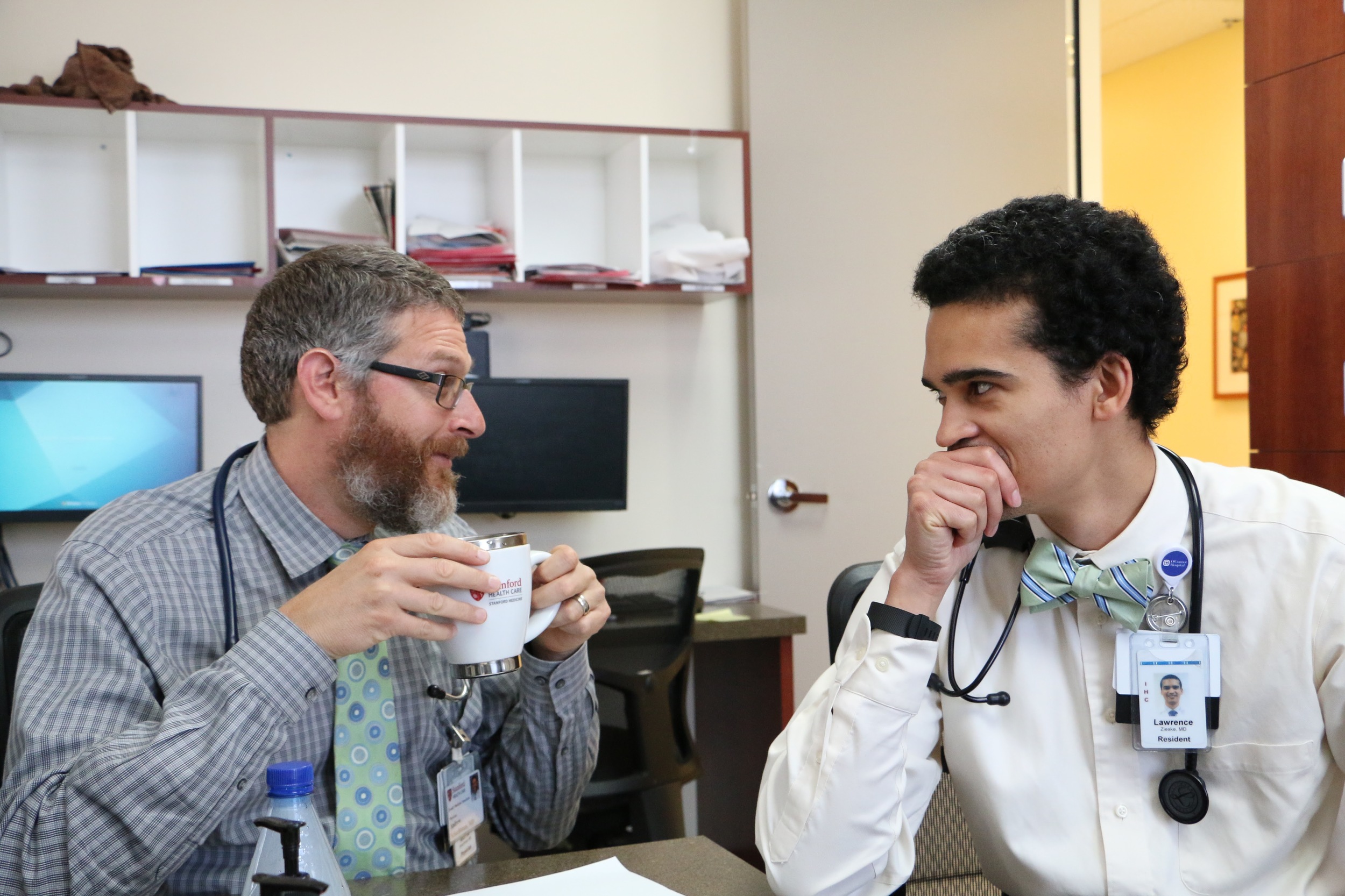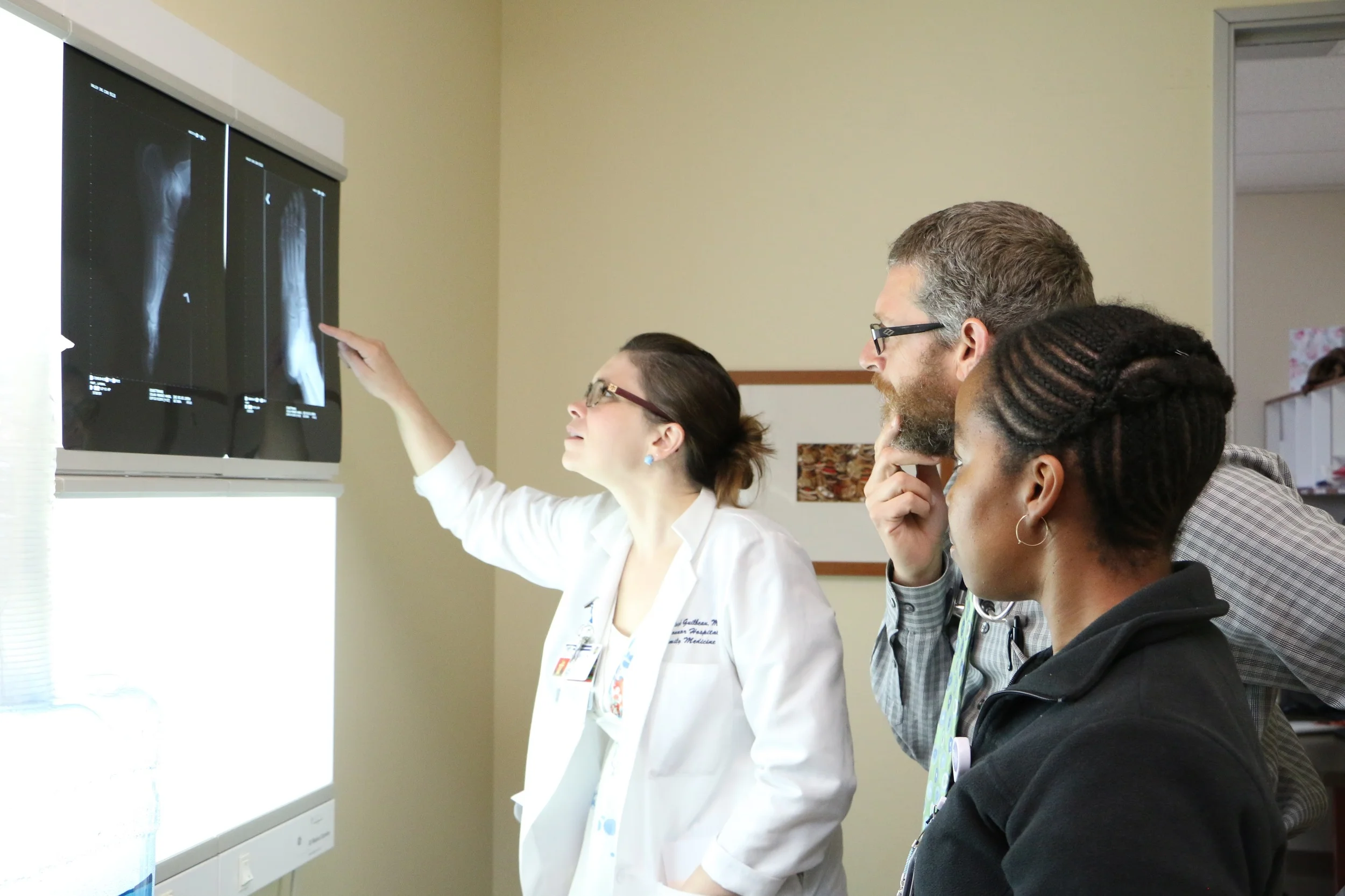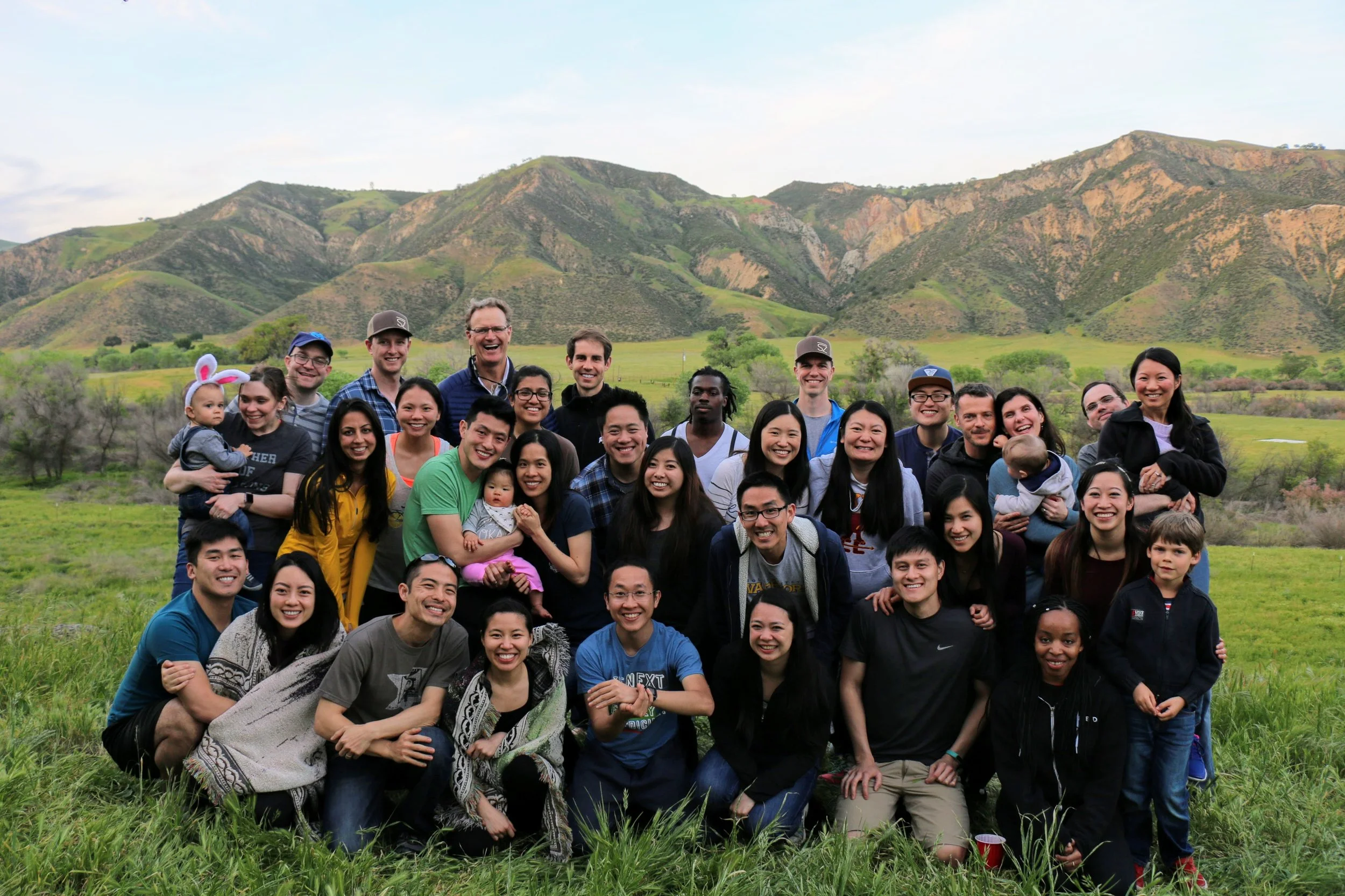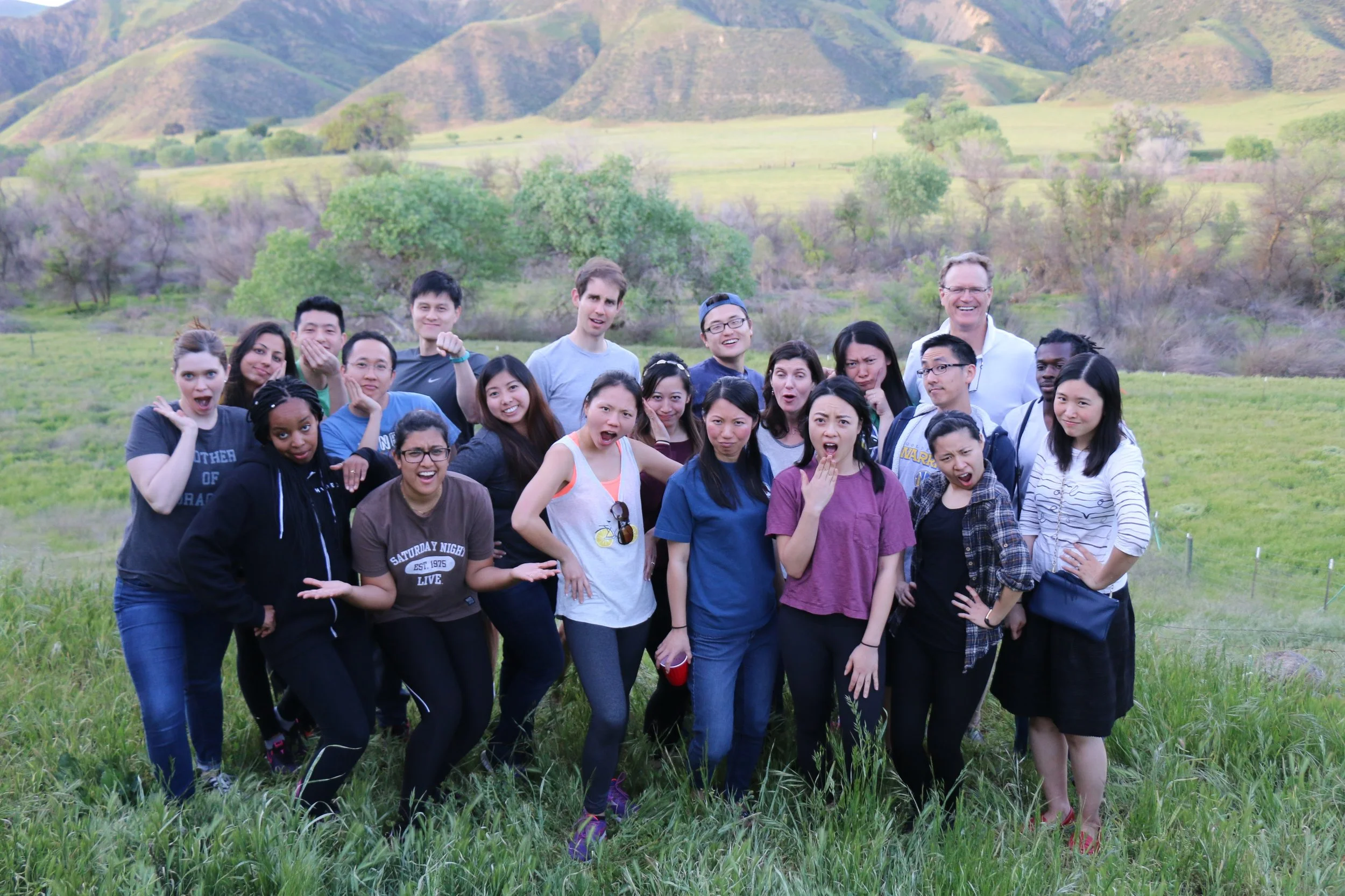







Learning Environment
Learning Environment
What is the relationship like between the residents and the faculty?
There’s a wonderful collegial relationship between the residents and the faculty. The faculty treat the residents like future family physician colleagues. The faculty are approachable and easy to talk to. They encourage and support residents who wish to pursue individual areas of interest.
What’s the balance between work and learning?
The residency does a good job of balancing the work and educational needs of the residents. High quality patient care is our number one priority. This often requires a lot of hard work but we aim to achieve a good balance for residents to make full use of their clinical time.
Are residents involved in making changes to the residency program?
Yes! Residents have extensive opportunities to contribute to and shape the residency program. One example is the Family and Community Medicine month where residents work on a project that often focuses on quality improvement areas in the Family Medicine Center or our hospital service. Residents are also involved in key committees throughout the hospital and within our program, and do periodic curriculum review and faculty evaluation. Feedback from the residents and our graduates is the cornerstone for continuing to improve and evolve the residency over time.
Does your program adhere to residency work hour limits?
Our residency program strictly adheres to ACGME residency work hour limits both because it’s required and because we believe it’s best for the health of our residents and our residents’ patients. On busier rotations, residents are released from post-call responsibilities that would keep them past their designated work hour limits. Because of our night float system, many of our rotations have little or no call responsibility. This allows the residents to be well rested.
Will I have autonomy in the care of my patients? Will they be my patients or my attending’s patients?
As the resident taking care of your patients in the Family Medicine Center and the hospital, you will be their doctor. The attending family medicine faculty serve as your consultants and advisors as you care for your patients. A minority of our hospitalized patients see one of our faculty physicians as their primary doctor. In these cases, the resident in charge of their inpatient care coordinates the patient’s care with the attending physician. We are the hospitalist service for O’Connor Hospital admitting any “undoctored” patients, or patients whose doctors do not have privileges at O’Connor. We do not admit patients or serve as a labor source for doctors who do have privileges at O’Connor.

Curriculum
Curriculum
HOW MUCH DIDACTIC TIME IS THERE? ARE RESIDENTS PROTECTED FROM OTHER OBLIGATIONS DURING SCHEDULED TEACHING SESSIONS?
Our Didactic Curriculum has been overhauled over the past few years. To protect educational time and enhance our residents' learning, we transitioned to a weekly 2.5 hour block didactic series on Wednesday afternoons, for which all of our residents are excused from their other clinical duties to attend and which showcases some of the most innovative teaching methods in residency education, such as our interactive "Wednesday Mystery Cases" (modeled after the Tulane Friday School Curriculum). In addition, during noontime on the other days of the week, residents participate in hospital Grand Rounds, shorter teaching sessions (such as senior resident-led "Chalk Talks"), committee meetings, Balint group, res-fac meetings, intern support group, and our Behavioral Science didactic series. Didactic and interactive sessions are taught by our Family Medicine faculty and by visiting subspecialists. Journal clubs and morbidity and mortality (M&M) conferences occur monthly. Residents are not scheduled for work responsibilities during these educational sessions and are expected to attend unless they are attending to an urgent patient care need such as a code or delivery. In addition, throughout the year, residents are relieved from work responsibilities to attend a series of class-specific small group Behavioral Science workshops covering various topics.
WHAT TYPES OF LEARNING ARE AT THE PROGRAM?
Our curriculum is designed to address the needs of our urban, underinsured, multicultural and medically underserved community. Different educational modalities used in our residency program include the following:
Traditional clinical experiences in the hospital and outpatient settings
Experiential learning in chronic illness care (through facilitation of group visits, planned visits, and panel management)
Self-directed learning via electronic educational resources available through the O'Connor and Stanford Medical Libraries
Use of models for procedural training
Simulation-based learning (i.e, mock codes)
Traditional didactic lectures, small-group seminars and workshops incorporating Active Learning Methods
Direct observation and feedback of clinical encounters by medical and behavioral science faculty
A structured quality improvement curriculum that exposes residents to core concepts of continuous quality improvement and population management.
In 2017, we piloted an exciting addition to our didactic curriculum during our 2.5 hour block didactics. Designed to model Problem-Based Learning in medical schools and the Tulane Internal Medicine Residency Program “Friday School,” our Mystery Cases encourage teamwork, case-based learning, cost-conscious health care, self-directed learning, and peer teaching of clinical pearls.
What sort of elective opportunities will I have?
The elective options are wide open. Residents have two months of electives, one of which can be anywhere in the world.
Recent elective choices included international work in Santa Clotilde, Peru, working with a local midwife/obstetrician group, dermatology in Hawaii, medical volunteer work in Vietnam, office-based procedures with our attendings, and Sports Medicine ultrasound in Colorado. In addition to the elective months, residents can choose a “selective” in the second year which allows for additional time rotating in subject matter that the resident chooses (such as Cardiology, Pediatrics, Dermatology etc). Finally, our faculty are involved in a wide variety of clinical activities such as teaching, volunteering in local free clinics, and staffing sports events and frequently invite residents to join them.
Are there opportunities for international health rotations?
Residents have the opportunity to do a one month away elective which can be done internationally. Our program has an association with a free clinic based in Roatan, Honduras (coincidentally also a gorgeous beach, snorkeling, diving destination) that several of our residents and faculty have rotated through. Other overseas elective opportunities are also available and residents are free to set up their own rotation for their away elective month. We are exploring the option of creating a formal global health track within our residency program, as part of the Stanford/Yale Johnson & Johnson Global Health Scholars Program.
Will I have the opportunity to do scholarly activity like research or writing journal articles?
Our program does not have a research or publication requirement but there are several opportunities for scholarly activities for those who are interested. All residents develop projects as part of their Family and Community Medicine month. These have the potential to be presented as poster presentations at national conferences. Faculty have co-presented with residents at national Family Medicine conferences and have collaborated with residents on articles for the Family Medicine journals and textbooks. Residents with a particular interest in academic Family Medicine may participate in the OSLER program during their training.
HOW MUCH OB DO YOU DO?
Our residents exceed the number of deliveries required for family medicine residency graduates. The average number of deliveries completed by our last two graduating classes was 60, although there is a wide range based on individual resident interest. Residents also get experience with the full spectrum of labor management, vacuum assisted deliveries, and assisting with Cesarean sections. Residents do 1.5 high volume months of obstetrics training at Valley Medical Center, the local county hospital. Three of our core family medicine faculty have active maternity care practices. Two of our family medicine faculty perform C-sections as primary surgeon.
Do residents rotate AT HOSPITALS OTHER THAN O’CONNOR HOSPITAL?
Fortunately, the majority of the residency training is based at our home institution. This allows our residents to work in a familiar environment and to participate in regularly scheduled didactic sessions. There are a handful of rotations that are based outside of O’Connor Hospital in order to supplement the training available at our host institution. First year residents do a total of two months away (split up into 2 week blocks): 4 weeks of intense labor and delivery at Valley Medical Center, the local county hospital, and 4 weeks of inpatient pediatrics at Kaiser Santa Clara. Second year residents spend 4 weeks away doing outpatient gynecology and building their obstetrics experience by taking L&D call at Valley Medical Center.
ARE THERE ANY OTHER RESIDENCY PROGRAMS AT O'CONNOR HOSPITAL?
There are no other residency programs at O’Connor Hospital – it is “unopposed.” Being an “unopposed “ program means our residents get exposure to the full scope of interesting clinical cases and procedures. There is no competition with other programs for certain patients or procedures. Similarly, at O’Connor Hospital, our residents interact directly with our attending sub-specialists, while serving as the primary physician for patients.

Clinic Life
Clinic Life
Does the residency clinic use an electronic medical record (EMR)?
The O’Connor Family Medicine Center has used an EMR since 2007. Our outpatient clinic currently utilizes eClinical Works but we are excited to announce that we will be transitioning to Epic in Summer 2022!
Does your program work with socioeconomically underserved populations?
The IHC Family Medicine Center is a Federally Qualified Health Center (FQHC), meaning that we care for an underserved patient population. The majority of the patients we see in the Family Medicine Center are covered by Medi-Cal, California’s version of the Medicaid program that covers low income patients. Other patients have Medicare or are uninsured. In the hospital, we take care of all comers. Our inpatient patient population is a mix of uninsured, Medi-Cal, Medicare, and privately insured patients.
What is a clinic session in the Family MEDICINE Center like?
Clinic sessions are a mix of acute care, preventive health, and chronic disease management. First year residents start off seeing 3-4 patients per half day in clinic and ramp up to six patients per half day as they become more comfortable. By the third year, residents are seeing 8-12 patients per half day. Faculty physicians are always available in the clinic for consultation, to help with patient care, and for teaching.
WILL I GET EXPERIENCE CONDUCTING GROUP PATIENT VISITS?
Absolutely! The Family Medicine Center, our residency clinic, hosts regular group visits for diabetes, pediatric obesity, smoking cessation, chronic pain, and adult obesity/lifestyle management. Residents have the opportunity to facilitate these group visits, which focus on enhancing patient self-efficacy, medical knowledge, and support within the group setting.

Resident Life
Resident Life
What's life like in San Jose?
San Jose and its surrounding areas are great places to live. It’s a low-density urban environment. You can find what you are looking for. There are old neighborhoods with quiet, tree-lined streets that are great for raising a family. There are apartments in downtown San Jose within walking distance to nightlife, the Sharks stadium (ice hockey), and great restaurants. If you like dining out, you’ll never get tired of your choices. In addition to standard fare, San Jose has great Vietnamese and Ethiopian food. People love the year-round excellent weather in San Jose and plethora of outdoor activities available.
Are most of the residents married or single? Do the residents socialize as a group?
Just over 50% of our current residents are married, and one or two residents in each class have children. Both married and single residents participate in post-work social events such as dinners out, barbecues, movie nights, and hikes. These are organized monthly by a resident who volunteers to be the Social Chair, and informally by everyone. Many of our residents form strong friendships that last long after residency ends.
Would this be a good place for me and my family? Is it a good place to raise young children?
Since San Jose is situated in the heart of Silicon Valley, job opportunities for your spouse abound. The headquarters for eBay, Google, PayPal, Yahoo!, Apple, and Cisco are within 20 minutes of the hospital. San Jose is also a great place to raise a family. San Jose is ranked as the #1 safest city with a population over 500,000. Happy Hollow Park and Zoo caters to young children and has just completed major renovations. The Children’s Discovery Museum is a fun-filled learning environment. Older children will love the Tech Museum.
WHAT FUN THINGS ARE THERE TO DO IN AND AROUND SAN JOSE?
San Jose’s beautiful weather makes outdoor activities such as hiking and bicycling available year round. San Jose is also surrounded by great places to visit: San Francisco, Napa Valley, and Monterey/Carmel are all within easy access for a day trip. A few hours’ drive gets you to skiing around Lake Tahoe or hiking in Yosemite National Park.

Miscellaneous
Miscellaneous
WHAT MAKES THIS PROGRAM DIFFERENT FROM OTHER FAMILY MEDICINE RESIDENCY PROGRAMS?
Many of the positive features of our program combine to make it a top notch place to train. O’Connor Hospital, a community-based, family medicine friendly hospital without other residency programs, is an ideal place to train in family medicine. Our success in attracting talented residents and the strength of our faculty mean that you will be surrounded by smart, engaging colleagues who will support you while pushing you to achieve your fullest potential. Are the residents pleased with their residency training at O’Connor Hospital? We survey residency program alumni to get feedback on how we can continue to improve the residency training to meet evolving real world practice needs. Results from our latest survey found that our graduates report feeling well prepared to practice family medicine in the community, and 100% would have chosen this residency program again.
WHY IS O’CONNOR HOSPITAL A GOOD HOSPITAL FOR RESIDENCY TRAINING?
O’Connor Hospital is a good place to train family doctors for several reasons. As a community-based hospital, our patient population reflects the diseases and problems seen by practicing family doctors. Esoterica requiring sub-sub-specialists is the exception here rather than the rule. Our residents become expert in the management of common medical conditions they will be seeing in their future practices. Because it is an “unopposed” program, family residents are never forced to compete for interesting patients or procedures. O’Connor Hospital has only been a teaching hospital since 2005. As a result, we find that many of O’Connor Hospital’s specialists are eager to work with the residents and enjoy teaching.
HOW WELL ARE FAMILY PHYSICIANS AND RESIDENTS TREATED AT O’CONNOR HOSPITAL?
Family physicians have a strong presence in O’Connor Hospital. Family medicine staff physicians and residents are treated as respected colleagues.
What do your graduates do?
Most of our residency graduates work as employed physicians within multi-specialty groups in the Bay Area, both in private practice/academic institutions and community clinic settings caring for the insured as well as underserved populations. About one per year pursue fellowship training. Some have joined our faculty or have taken faculty positions with other residency programs or medical schools. The majority of our graduates work in outpatient settings with some continuing hospital work and prenatal care/obstetrics.
How stable is the residency program? And the faculty?
The program is very stable. In 2004, when San Jose Medical Center, our sponsoring institution at the time, announced its impending closure the program moved almost seamlessly with its residents and faculty to our new home at O’Connor Hospital. The residents were able to continue their training without interruption. The faculty group is very stable as well, with most of the faculty serving for more than 10 years. Within the past five years, we have introduced four core faculty members to our program and are committed to continuing faculty development of all junior and seasoned faculty. Dr. Norman served as the Program Director from 1986-2016, and Dr. Yu assumed the role of Program Director in 2016. In 2017, Stanford University Medical Center assumed sponsorship of our program, further solidifying the stability of our program and expanding the resources available to our trainees.
How often will I be on call at this residency program?
This varies by class year and is continually modified to comply with the latest ACGME Duty Hour Requirements. Since switching to a Day Team/Night Team structure for inpatient coverage several years ago, we have vastly simplified and reduced our call schedule to weekends only. Currently, all residents do two 2-week blocks of night float which covers the hospital from roughly 6:30PM-7:30AM on Sundays through Thursdays. Intern call is split evenly between the 8 interns and averages out to a little over 1 day or evening call per month throughout the year (to accommodate call free months and vacations we don’t follow a strict call routine). On away rotations at Kaiser and VMC call is approximately once a week. Senior call is split evenly between all R2s and R3s.
What is the retention rate of your residents?
The retention rate of our residents is nearly perfect. In the past decade there have been a handful of residents who have interrupted their training to pursue other career paths or to train elsewhere, but almost universally our residents complete their training with the program.
How well do residents do on board certification exams?
Our residency graduates have a 100% pass rate on the board certification examinations.
Do I get free food and free parking?
Our residents receive a generous quarterly meal stipend of $780 at O’Connor Hospital, given regardless of rotation or hours worked per shift. The O’Connor Hospital cafeteria offers lots of tasty options including grill specials (gyros and paninis were a recent feature). Periodically, the residency program provides free meals or other perks to keep us well fed. Parking is also free.
HOW MUCH VACATION TIME WILL I GET?
The current schedule gives 3 one-week vacations for PGY-I's and 4 one-week vacations for PGY-II's and PGY-III's.

Applications
Applications
Do you offer clerkShips, subinternships, or observerships at your program?
We offer inpatient and outpatient clerkships and subinternships with the residency program. Our most popular medical student rotation is a one month block that is split between the inpatient and outpatient settings: two weeks working in the Family Medicine Center and two weeks on the inpatient family medicine hospital service. These fill up quickly so if you are interested, contact our administrative assistant, Diep Nguyen, to set it up. We do not currently offer observership positions. We are also happy to arrange “second look” opportunities for serious applicants.
Do I need to do a clerkship or sub-internship at your program to have a good chance of matching?
Doing a rotation with us is a great way for you to get to know our program and for us to get to know you. The more information we all have, the better we’ll be able to determine if we are a good fit. That said, a rotation with us is neither expected nor required. We prefer to see applicants who have used their third and fourth year elective time to deepen their exposure to various areas of medicine rather than doing a string of family medicine “audition” rotations.
Does your program accept applications from international medical graduates?
We accept applications from international medical graduates through ERAS. Demonstration of supervised clinical practice in the United States is required for applicants being considered.

Why I Love OCH
Why I Love OCH
What do you like most about Our Program?
“I could say that our attending are brilliant and supportive, that our patients are diverse and offer incredible learning, and that our work environment fosters incredible growth and teamwork. While this is true, what stands out most is the people, whether it be my co-residents, my attending, or the staff we work with. I look forward to coming to work everyday because I get to see some of my favorite faces. They truly are my second family!”
“I’m thrilled to be at O’Connor because the residents, faculty, and staff are so kind and supportive and they foster a very positive learning and work environment.”
“The people!! The residents are fun, down-to-earth, amazing people that will not only have fun with you during the good times but also not hesitate to help you out when you are down. Our attendings are all unbelievably knowledgeable about every aspect of family medicine, plus they each have strengths in individual areas (geriatrics, OB, procedural medicine, sports, etc.) that complement each other and enhance our training. Even more amazingly, every single one of them is someone you could call in the middle of the night or pull aside for a question or concern. They really, really care!”
“Great camaraderie amongst residents and faculty, ability to practice full-spectrum FM, commitment to education in primary care, and dedication to continuous quality improvement.”
“The thing that I love the most about this program is the people. The faculty are amazing and great teachers, I’m always surprised how kind and generous my co-residents are, and lastly the patient population continues to inspire me to be a better physician.”
“O’Connor is an extremely positive environment and focuses not just on caring for patients but also on teaching. I feel very fortunate to be able to return to my passion and be a part of such a great place to learn medicine.”
“The amazing people here foster a nurturing environment that feels at once stimulating and family-like. One minute we’re discussing complicated patients together in clinic, and the next we’re getting our hands dirty with spicy seafood at Boiling Crab.”
“The residents are bright, energetic, and engaging. They teach me something new everyday.”
“It feels like home.”
“O’Connor’s Family Medicine program is the residency of my dreams: a community-based, university-affiliated, unopposed program where the training is rigorous and the people are happy and down-to-earth. I love the amazing faculty and residents, nurturing environment, and exceptional quality of teaching. San Jose also happens to be one of my favorite cities — a diverse and vibrant community where I can serve people from all walks of life.”
“I have a lot of reasons, but the solid OB experience, balanced peds experience (both at a tertiary care center and community hospital), nightfloat system, and culture of support among residents are important to me. Also call here is a true family medicine experience—one minute you’re admitting a patient to the ICU, then next your answering floor calls on a pedi patient or delivering a baby. It’s really fun, and great preparation for anything. ”
“A terrific group of faculty and residents who engage me intellectually and personally each and every day.”
“I was attracted to O’Connor due to the full spectrum, rigorous academic atmosphere, diverse patient population, and fierce dedication to the underserved.”
“In my wildest dreams, I could not have assembled a better faculty group. We have the best group of attendings with very diverse interests (in medicine and outside of medicine), personalities, and styles. They are all incredibly smart, but at the same time incredibly supportive and friendly. I like and respect every single one of them.”
“Amazing faculty, friendly residents, diverse and underserved patient population, and free food at the cafeteria!”
“Hands down, the people. Both attendings and residents are able to joke, laugh, have fun and provide excellent, evidence-based patient care!”



